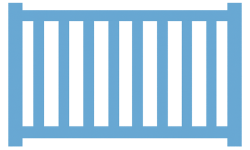Have you ever dreamed of adding a touch of elegance and security to your property with a fence? Many homeowners struggle to find the right fence that meets their needs for durability and aesthetics. Today, we at Utah Fencing Company will guide you through the Installation of a commercial-grade Aluminum Fence, perfect for those in Salt Lake, Davis, and Utah Counties who seek both style and resilience.
Understanding Aluminum Fences
Why choose aluminum for your fence? Aluminum fences are known for their durability, low maintenance, and elegance. Unlike iron, they don’t rust, and unlike Wood, they don’t warp. For homeowners looking to enhance both security and curb appeal, aluminum is a stand-out choice.
Another perk is the variety of styles available. Whether you want something simple or elaborate, there’s likely a design that complements your property. You get a combination of strength and beauty, making it a win-win for any homeowner.
Tools and Materials You Will Need
A successful installation begins with having the right tools and materials at your disposal. Not only will this save you time, but it also prevents unnecessary trips to the hardware store. Preparation is key to ensuring a smooth process.
Common tools needed include a post-hole digger, level, measuring tape, and Concrete mix. Additionally, ensure you have all fence-specific components like panels, posts, and brackets. We recommend double-checking everything before you start to ensure nothing is overlooked.
Planning Your Fence Layout
Before you start digging, planning your fence layout is crucial. This involves understanding property lines, marked utilities, and any zoning regulations that may apply. A well-thought-out layout makes the installation process efficient and hassle-free.
Begin by sketching your intended fence line and marking the spots where posts will go. This step allows you to visualize the result and make any necessary adjustments beforehand. Use stakes and string to outline your fence; this will guide your next steps.
Marking and Digging Post Holes
Marking and digging post holes might sound simple, but it requires precision. Accurate marking ensures that your fence stays straight and level. Measure twice, dig once is the philosophy we adhere to for a top-notch installation.
Each hole should be about two feet deep, depending on the height of your fence. A post-hole digger or auger can make this task easier, especially in hard soil. It’s crucial to keep these holes consistent for a neat and stable fence.
Setting the Fence Posts
Setting fence posts correctly is where your aluminum fence begins to take shape. This step ensures the stability and longevity of your fence. Use a level to check each post as you set it in place to maintain an even height.
Mix concrete according to the instructions and pour it into the holes around the posts. Allow the concrete to set for at least 24 hours before adding the fence panels. This waiting period is essential to ensure that your posts are firmly secured in place.
Attaching Fence Panels
Once your posts are set, attaching the fence panels brings your vision to life. Panels are usually pre-assembled, making this step straightforward. Align each panel between the posts and secure them with brackets included in your kit.
It’s crucial to keep panels at the same height for a pristine appearance. Use your level as you go along, making adjustments as necessary. A uniform look not only boosts curb appeal but also signals a professional installation.
Incorporating Gates
Adding a gate is often the final touch on a fence installation. Gates provide both functionality and access, and they should seamlessly integrate with your fence design. Ensure your gate swings freely and latches securely.
When installing a gate, give special attention to the stability of the posts on either side. These need extra support to handle the weight and movement of the gate. Proper gate installation enhances the usability and security of your new aluminum fence.
Finishing Touches
Our last step is all about the details. Walk along your fence to check for any inconsistencies you might want to tweak. Touch up any scratches with paint designed for aluminum to maintain the fence’s aesthetics.
Ensure all screws and brackets are fastened tightly and check that the gate operates smoothly. These finishing touches can significantly extend the life of your fence and add to the overall satisfaction of a job well done.
Maintenance Tips for Aluminum Fences
Now that your fence is installed, keeping it in top condition is a breeze. Aluminum fences are low-maintenance, but a little care goes a long way. Regular inspection ensures it remains in pristine condition.
Typically, all you need to do is clean it with a mild detergent when it gets dirty. Check periodically for loose screws or brackets and tighten them as needed. These simple practices will preserve both the appearance and the stability of your fence.
Common Installation Mistakes to Avoid
- Skipping the planning phase can lead to complications later on, such as unstable posts or uneven panels.
- Ignoring property lines might result in disputes with neighbors or legal issues, especially in stricter regions.
- Inconsistent post depths lead to a wavy appearance, affecting both aesthetics and structural integrity.
- Using the wrong tools can make installation unnecessarily difficult, increasing the risk of mistakes.
- Rushing the concrete setting phase can undermine the entire installation’s stability and longevity.
Conclusion
Installing a commercial-grade aluminum fence is a rewarding project that enhances both the security and beauty of your home. For personalized assistance or further questions, contact us at Utah Fencing Company by phone at 801-905-8153 or Request a Free Quote today!




